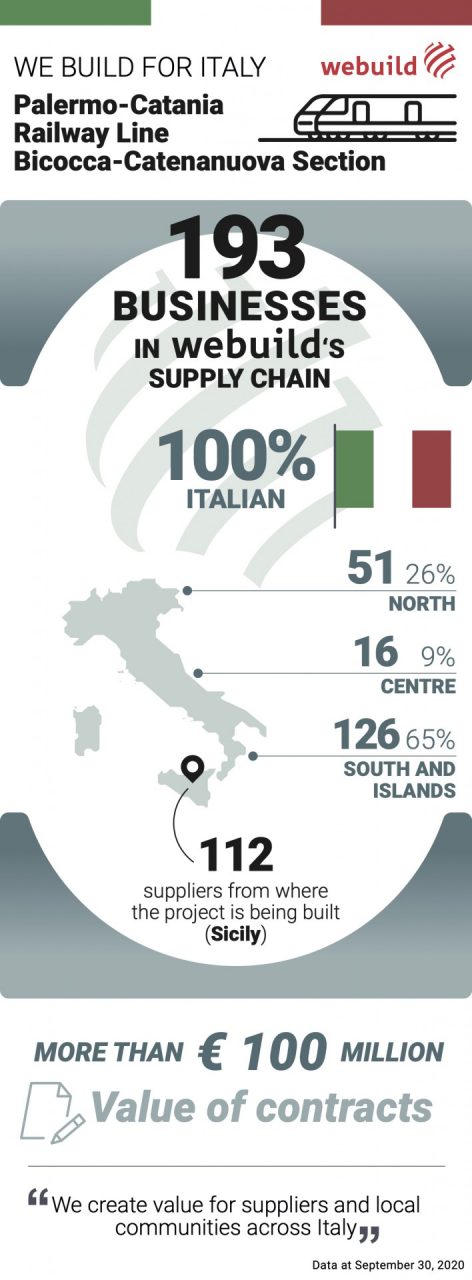The last stretch of “Europe’s subway” is under construction in Sicily, the southern-most tip of a line that starts in Berlin and will end in Palermo.
This is the final section of one of the TEN-T networks funded by the European Union, an infrastructure project that is strategic for Sicily because the island will soon have a high-capacity railway for the first time in its history. The line will connect Sicily’s two most important cities, Palermo and Catania, which are currently linked by an old single-track railway that requires trains in transit to stop so that trains arriving from the opposite direction can pass.
The project will result in a profound improvement in the island’s mobility, halving the transit time between the two cities to less than two hours, thanks to trains that will run speeds of up to 200 km per hour (124 mph) while skimming through the Sicilian countryside.
The line that will bring Palermo closer to Catania
The first step towards a more modern transport network is a stretch of track 38 kilometers (23 miles) long, which joins the town of Bicocca (near the airport of Catania) with Catenanuova (in the province of Enna), where the single track will be replaced by a double one. The project is commissioned by Italy’s state-owned Rete Ferroviaria Italiana with an investment of €195 million, and is being built by Webuild Group.
Trains running on this stretch today cannot exceed speeds of 90 km/h (55 mph) and are obliged to stop to let others pass because of the single track. Doubling the tracks will enable the trains to reach speeds of 200 km/h (124 mph).
Work at the construction site is in full swing, and has not stopped despite the Covid-19 pandemic. By respecting social distancing rules and other safety measures, as many as 430 people have continued to work without ever interrupting traffic on the old line.
“The work takes place almost entirely on the surface, with the construction of viaducts up to 500 meters (1,640 feet) long that cross two rivers, the Simeto and the Buttaceto,” explains engineer Fabio Michele Ruffo, project manager of the Bicocca-Catenanuova section. “These are complex and large-scale works, with earthwork operations reaching 1.5 million cubic meters (1.8 million cubic yards) and many small intersections. All this without interrupting service on the traditional line.”
The supply chain supporting a major project
Working alongside Webuild Group on the Bicocca-Catenanuova railway is a small army of highly specialised companies — a total of 193, including suppliers and subcontractors. They are all Italian: 58% come from Sicily itself, followed by Lombardy and Veneto. These are small- and medium-sized companies, but also institutions representing the academic world.
Natisone Lavori, for example, is using its patented “Ponte GU.I.DO.” technology, a complex temporary support system for railroad tracks that is designed to allow trains to travel on speeds up to 80 km/h (49 mph) on certain points along the route, avoiding the need to cut rails or stop service.
“GUI.DO. is a railway homologation we designed by paying close attention to the sector’s evolution,” says Natisone Lavori works director Giuseppe Guidi. “We want to stay in step with the times, with cutting-edge technologies and solutions in compliance with current regulations, the environment and safety in the workplace.”
This patented system introduced a new way of laying a double track that enables the construction firm to lay this new and safer track in a shorter time.
Natisone Lavori, a Veneto-based company founded in 2001, is one of the many subcontractors working on the construction site. At their side are also research institutes such as the Center for Applied Economics Studies in Engineering (CSEI), of which the University of Catania is a member.
“Our activity within the construction site regards remote sensing techniques using high-resolution satellite images,” explains Professor Simona Consoli, CSEI contact person for the project. “The aim is to map the area affected by the excavation of the railway line and the characteristics of the crops affected by the work and the infrastructure.”
In essence, the Center’s analysis, carried out by a team of researchers and agronomists, allows Webuild to study changes in the landscape affected by the construction site in order to avoid damage the valuable citrus groves that surround the new railroad line. To date, the results confirm that the vegetation around the worksite has not been affected — yet more proof that a sustainable project is being carried out by a worksite designed to protect and safeguard the environment.

